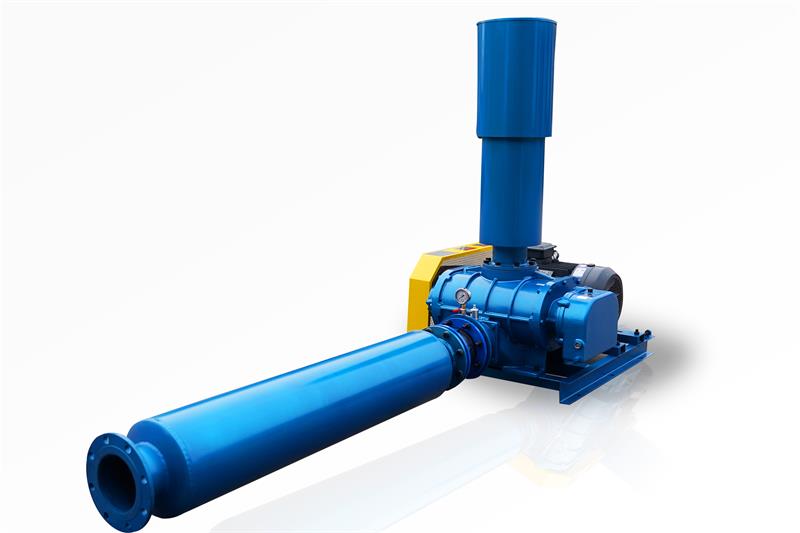污水處理曝氣風(fēng)機(jī)選擇中應(yīng)注意的幾個(gè)問(wèn)題:
Several problems should be noticed in the selection of aeration fan for sewage treatment:
1�、根據(jù)實(shí)際情況計(jì)算參數(shù)
1. Calculate parameters according to actual conditions
在污水廠選擇污水處理曝氣風(fēng)機(jī),廠家產(chǎn)品樣本提供的都是標(biāo)準(zhǔn)進(jìn)氣狀態(tài)的性能參數(shù)�����,但風(fēng)機(jī)實(shí)際使用時(shí)不是標(biāo)準(zhǔn)狀態(tài)��,風(fēng)機(jī)的環(huán)境條件(如溫度����、大氣壓力、海拔等)不同時(shí)�,風(fēng)機(jī)的性能也會(huì)發(fā)生變化。設(shè)計(jì)選擇時(shí)不能直接使用產(chǎn)品樣本的性能參數(shù)�,相反,根據(jù)實(shí)際使用狀態(tài)��,風(fēng)機(jī)的性能要求必須轉(zhuǎn)換為標(biāo)準(zhǔn)進(jìn)氣狀態(tài)的風(fēng)機(jī)�����。
When the sewage treatment aeration fan is selected in the sewage treatment plant, the performance parameters provided by the manufacturer's product samples are all in the standard intake state, but the actual use of the fan is not in the standard state. The performance of the fan will also change when the environmental conditions of the fan (such as temperature, atmospheric pressure, altitude, etc.) are different. The performance parameters of the product sample cannot be directly used in the design selection. On the contrary, according to the actual use status, the performance requirements of the fan must be converted to the standard intake status of the fan.
2、出口壓力的影響因素分析
2. Analysis of influence factors of outlet pressure
容積鼓風(fēng)機(jī)排氣壓力的高低并不取決于鼓風(fēng)機(jī)本身����,而是由氣體從鼓風(fēng)機(jī)排出后的裝置�����,即所謂的“背壓”來(lái)決定����,污水處理曝氣風(fēng)機(jī)具有強(qiáng)制氣體輸送的特點(diǎn)。
The exhaust pressure of the volumetric blower is not determined by the blower itself, but by the device after the gas is discharged from the blower, namely the so-called "back pressure". The sewage treatment aeration fan has the characteristics of forced gas transmission.
鼓風(fēng)機(jī)銘牌上顯示的排氣壓力是風(fēng)機(jī)的額定排氣壓力�,實(shí)際上,鼓風(fēng)機(jī)可以在低于額定排氣壓力的所有壓力下工作�,只要強(qiáng)度和排氣溫度允許,就可以超過(guò)額定排氣壓力���。
The exhaust pressure shown on the nameplate of the blower is the rated exhaust pressure of the blower. In fact, the blower can work at all pressures lower than the rated exhaust pressure. As long as the strength and exhaust temperature allow, the rated exhaust pressure can be exceeded.
污水處理廠的情況是��,排氣系統(tǒng)產(chǎn)生的壓力(背壓)是管道系統(tǒng)的壓力損失值���、曝氣池水深和環(huán)境大氣壓力的總和。由于某些原因���,例如�,由于曝氣頭或管道堵塞,管道系統(tǒng)的壓力損失增加�,背壓上升,風(fēng)機(jī)的壓力也會(huì)相應(yīng)增加���。另外��,由于曝氣頭破裂或管道泄漏等原因�,管道系統(tǒng)的壓力損失減少�����,背壓持續(xù)降低����,風(fēng)機(jī)的壓力也降低。
In the case of sewage treatment plants, the absolute pressure (back pressure) generated by the exhaust system is the sum of the pressure loss value of the pipeline system, the water depth of the aeration tank and the ambient atmospheric pressure. For some reasons, for example, due to the blockage of the aerator or pipe, the pressure loss of the pipe system will increase, and the back pressure will rise, and the pressure of the fan will also increase accordingly. In addition, due to the rupture of the aerator or or pipeline leakage, the pressure loss of the pipeline system is reduced, the back pressure continues to decrease, and the pressure of the fan is also reduced.
綜上所述�,在確定污水處理曝氣風(fēng)機(jī)壓力時(shí),只要風(fēng)機(jī)在標(biāo)準(zhǔn)狀態(tài)下能達(dá)到的壓力�,就等于使用狀態(tài)下的大氣壓力、曝氣池水深和管道損失之和���。
To sum up, when determining the pressure of the sewage treatment aeration fan, as long as the fan can reach the pressure under the standard state, it is equal to the sum of the atmospheric pressure, the depth of the aeration tank and the pipe loss under the use state.
3����、鼓風(fēng)機(jī)氣流因素
3. Blower airflow factor
計(jì)算污水處理的氧氣需求時(shí),結(jié)果是標(biāo)準(zhǔn)狀態(tài)下所需氧氣的質(zhì)量流量qm(kg/min)轉(zhuǎn)換為標(biāo)準(zhǔn)狀態(tài)下所需空氣的體積流量qv1(m3/min)�����,如果鼓風(fēng)機(jī)的使用狀態(tài)不標(biāo)準(zhǔn)(例如在高原地區(qū)使用)���,空氣密度、含水量也會(huì)發(fā)生變化����。
When calculating the oxygen demand of sewage treatment, the result is that the mass flow qm (kg/min) of oxygen required under the standard state is converted to the volume flow qv1 (m3/min) of air required under the standard state. If the use state of the blower is not standard (for example, in the plateau area), the air density and water content will also change.

因此,需要計(jì)算能夠提供相同質(zhì)量流的體積流�,即轉(zhuǎn)換流qv2。在高原地區(qū)使用時(shí)�,環(huán)境大氣壓力也會(huì)發(fā)生變化,壓力相應(yīng)提高�,鼓風(fēng)機(jī)的泄漏流量qvb會(huì)增加,鼓風(fēng)機(jī)供應(yīng)的空氣容積流量會(huì)減少����,氧氣供應(yīng)也會(huì)不足。
Therefore, it is necessary to calculate the volume flow that can provide the same mass flow, namely the conversion flow qv2. When used in plateau areas, the ambient atmospheric pressure will also change, and the pressure will increase accordingly, the leakage flow qvb of the blower will increase, the air volume flow supplied by the blower will decrease, and the oxygen supply will also be insufficient.
因此����,在設(shè)計(jì)時(shí)�,在使用條件發(fā)生變化時(shí)�����,考慮到各種因素的影響�����,風(fēng)機(jī)供應(yīng)的實(shí)際氣流必須滿足使用要求��,并計(jì)算轉(zhuǎn)換流量qv2和流出流量qvb2���。
Therefore, in the design, when the service conditions change, taking into account the influence of various factors, the actual air flow supplied by the fan must meet the service requirements, and the conversion flow qv2 and outflow flow qvb2 must be calculated.
4���、注意冬天和夏天的差異
4. Pay attention to the difference between winter and summer
風(fēng)機(jī)選型要注意風(fēng)機(jī)供應(yīng)流量的變化規(guī)律。也就是說(shuō)�,同樣的鼓風(fēng)機(jī)在冬天和夏天容積流量不變,但流量取決于空氣密度的質(zhì)量�,也就是說(shuō)氧氣供應(yīng)量會(huì)有所不同。
Pay attention to the change rule of fan supply flow in fan selection. That is to say, the volume flow of the same blower remains unchanged in winter and summer, but the flow depends on the quality of air density, which means that the oxygen supply will be different.
在標(biāo)準(zhǔn)狀態(tài)和使用狀態(tài)下��,鼓風(fēng)機(jī)的容積流動(dòng)不變����,但空氣密度��、含水量等發(fā)生變化���,冬季溫度降低時(shí),鼓風(fēng)機(jī)傳輸?shù)娇諝獬氐难鯕夤?yīng)增加��,夏季溫度升高時(shí)減少�����。例如��,某污水處理廠在上述計(jì)算實(shí)例中使用鼓風(fēng)機(jī)���,根據(jù)環(huán)境溫度的變化計(jì)算風(fēng)機(jī)的實(shí)際供氧,而該年的變化規(guī)律是�,在實(shí)際運(yùn)行過(guò)程中,由于進(jìn)水���、水質(zhì)���、水溫等參數(shù)的變化��,系統(tǒng)需氧量也在夏季變化��,冬季水溫降低�,曝氣池的需氧量減少�����。這是因?yàn)槎練鉁叵陆?���,空氣密度提高,風(fēng)機(jī)供應(yīng)的干空氣質(zhì)量比標(biāo)準(zhǔn)狀態(tài)大�,氧氣供應(yīng)量增加。從運(yùn)行的實(shí)際測(cè)量來(lái)看�,每年冬天暴露池的溶解氧比夏天高1 ~ 3毫克/L。
Under the standard and service conditions, the volume flow of the blower remains unchanged, but the air density and water content change. When the temperature decreases in winter, the oxygen supply transmitted by the blower to the air pool increases, and decreases when the temperature increases in summer. For example, a sewage treatment plant uses a blower in the above calculation example to calculate the actual oxygen supply of the blower according to the change of the ambient temperature. The change rule of this year is that during the actual operation process, due to the change of the parameters such as water inlet, water quality and water temperature, the oxygen demand of the system also changes in summer, and the water temperature decreases in winter, and the oxygen demand of the aeration tank decreases. This is because the temperature drops in winter, the air density increases, the dry air quality supplied by the fan is higher than the standard state, and the oxygen supply increases. From the actual measurement of operation, the dissolved oxygen in the exposure pool is 1~3 mg/L higher in winter than in summer.
因此�����,在生產(chǎn)運(yùn)行過(guò)程中�����,必須對(duì)這些變化及時(shí)調(diào)整設(shè)備�����,使風(fēng)機(jī)的充氧能力適應(yīng)實(shí)際運(yùn)行中的氧氣需求。對(duì)于污水處理曝氣風(fēng)機(jī)���,使用變頻器改變風(fēng)機(jī)速度調(diào)整送風(fēng)氣流是經(jīng)濟(jì)實(shí)用的���。
Therefore, in the process of production and operation, the equipment must be adjusted in time for these changes, so that the oxygenation capacity of the fan can meet the oxygen demand in actual operation. For the sewage treatment aeration fan, it is economical and practical to use the frequency converter to change the fan speed and adjust the supply air flow.
The above is the detailed introduction of Sichuan aquatic aeration equipment introduced for you. I hope it can help you. If you have any questions, please contact us. We will provide services for you with our attitude http://lzdbgs.com.cn/

